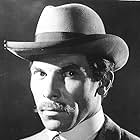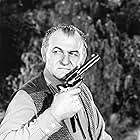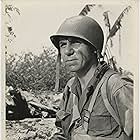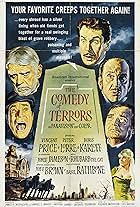VALUTAZIONE IMDb
4,9/10
147
LA TUA VALUTAZIONE
Il maggiore Robert Rogers e i suoi Ranger danno la caccia a una spia.Il maggiore Robert Rogers e i suoi Ranger danno la caccia a una spia.Il maggiore Robert Rogers e i suoi Ranger danno la caccia a una spia.
Keith Larsen
- Major Robert Rogers
- (filmato d'archivio)
Buddy Ebsen
- Sergeant Hunk Marriner
- (filmato d'archivio)
Don Burnett
- Ensign Langdon Towne
- (filmato d'archivio)
Philip Tonge
- General Amherst
- (filmato d'archivio)
Larry Chance
- Black Wolf
- (filmato d'archivio)
Angie Dickinson
- Rose Carver
- (filmato d'archivio)
Lisa Davis
- Elizabeth Brannen
- (filmato d'archivio)
Claude Akins
- Caleb Brandt
- (filmato d'archivio)
- (non citato nei titoli originali)
Jim Hayward
- Jonas, wounded settler
- (filmato d'archivio)
- (non citato nei titoli originali)
Charles Horvath
- Jake, Klagg Henchman
- (filmato d'archivio)
- (non citato nei titoli originali)
Emile Meyer
- Ben Klagg, Inn owner
- (filmato d'archivio)
- (non citato nei titoli originali)
Dale Van Sickel
- George, Klagg Henchman
- (filmato d'archivio)
- (non citato nei titoli originali)
Rebecca Welles
- Maureen Carver
- (filmato d'archivio)
- (non citato nei titoli originali)
Robert B. Williams
- Jed Parrott, Prisoner
- (filmato d'archivio)
- (non citato nei titoli originali)
Trama
Lo sapevi?
- QuizFrom the "Northwest Passage" TV series.
- BlooperAt the very beginning, as the native Americans run out of the woods, the safari pith helmet worn by one of the camera crew is visible at the lower right of the screen.
- Versioni alternativeA compilation of several episodes of the TV series "Northwest Passage."
- ConnessioniEdited from Northwest Passage (1958)
Recensione in evidenza
At first glance, this cheap, cheesy, episodic film might seem like a career low-point for director Jacque Tourneur, the man who had helped Val Lewton establish the psychological horror genre with "Cat People" and "I Walked with a Zombie" and who had made the prototypical film noir "Out of the Past." Here, we find Tourneur working with cardboard sets and cardboard actors. Only the most committed auteurists are going to find any hint of Tourneur's underrated genius. By this time, he had fallen off the map as an A-list director, largely because of his willingness to lower his own salary to make the films he wanted to make, but he was still able to get work at the major Hollywood studios. In this case, MGM.
But what neither of the other reviewers has pointed out, and what saves this movie slightly, is that it's actually not a movie at all. It's a medley of the first three episodes of the TV series "Northwest Passage," which ran for one season (1958-59). In those days, the major studios tried their hands at making TV series, usually with little success. This time, when the series ran its course, MGM cobbled together three different movies out of all the episodes, of which "Frontier Rangers" was the first. (The other two were "Mission of Danger" and "Fury River.") MGM probably unloaded these movies onto the drive-in market or as the second half of double bills.
Consequently, "Frontier Rangers" doesn't stand up very well as a movie. Tourneur had neither the resources nor the time to put together a quality show, and he had to settle for poorly lit scenes, supplemented by stock footage from MGM's earlier, far better 1940 film "Northwest Passage" (starring Spencer Tracy, and directed by King Vidor), upon which this series was loosely based. (Rather than watch any of these three films, I recommend that you try to catch the Tracy/Vidor flick instead.) Characters come and go without warning in "Frontier Rangers," and the sets are so flimsy that they move around during fight scenes. Were you to watch this in its original TV-series format, however, you should double my 3-star rating. It's about as good as other TV series in the "Western" genre (broadly defined). And it has Buddy Ebsen in the cast, which is a major plus!
Nevertheless, even as a patchwork movie, "Frontier Rangers" is interesting -- if for no other reason than the glimpse into 1950's values it provides. Remember, this was made before the Women's, Youth, and Civil Rights movements of the 1960s. So we get some fascinating insights into post-WWII attitudes about race, gender, and U.S. foreign policy: the authoritarian, militaristic virtues of Maj. Rogers; the fear of "indian" contamination of white blood, women, and culture; the submissiveness of long-suffering women who simply do not understand the importance of war and the pioneering spirit; etc. But of course, if you're whiling away 90 minutes on a rainy Saturday afternoon, you don't need to think so seriously about "Frontier Rangers." But I doubt you'll be able to make it all the way through without your mind wandering to some of these issues.
But what neither of the other reviewers has pointed out, and what saves this movie slightly, is that it's actually not a movie at all. It's a medley of the first three episodes of the TV series "Northwest Passage," which ran for one season (1958-59). In those days, the major studios tried their hands at making TV series, usually with little success. This time, when the series ran its course, MGM cobbled together three different movies out of all the episodes, of which "Frontier Rangers" was the first. (The other two were "Mission of Danger" and "Fury River.") MGM probably unloaded these movies onto the drive-in market or as the second half of double bills.
Consequently, "Frontier Rangers" doesn't stand up very well as a movie. Tourneur had neither the resources nor the time to put together a quality show, and he had to settle for poorly lit scenes, supplemented by stock footage from MGM's earlier, far better 1940 film "Northwest Passage" (starring Spencer Tracy, and directed by King Vidor), upon which this series was loosely based. (Rather than watch any of these three films, I recommend that you try to catch the Tracy/Vidor flick instead.) Characters come and go without warning in "Frontier Rangers," and the sets are so flimsy that they move around during fight scenes. Were you to watch this in its original TV-series format, however, you should double my 3-star rating. It's about as good as other TV series in the "Western" genre (broadly defined). And it has Buddy Ebsen in the cast, which is a major plus!
Nevertheless, even as a patchwork movie, "Frontier Rangers" is interesting -- if for no other reason than the glimpse into 1950's values it provides. Remember, this was made before the Women's, Youth, and Civil Rights movements of the 1960s. So we get some fascinating insights into post-WWII attitudes about race, gender, and U.S. foreign policy: the authoritarian, militaristic virtues of Maj. Rogers; the fear of "indian" contamination of white blood, women, and culture; the submissiveness of long-suffering women who simply do not understand the importance of war and the pioneering spirit; etc. But of course, if you're whiling away 90 minutes on a rainy Saturday afternoon, you don't need to think so seriously about "Frontier Rangers." But I doubt you'll be able to make it all the way through without your mind wandering to some of these issues.
I più visti
Accedi per valutare e creare un elenco di titoli salvati per ottenere consigli personalizzati
Dettagli
- Tempo di esecuzione1 ora 23 minuti
- Mix di suoni
- Proporzioni
- 1.33 : 1
Contribuisci a questa pagina
Suggerisci una modifica o aggiungi i contenuti mancanti

Divario superiore
By what name was Guerra indiana (1959) officially released in Canada in English?
Rispondi


































